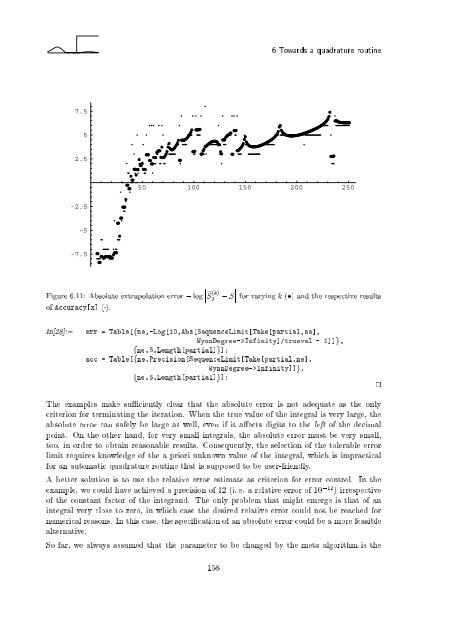Wave Propagation in Linear Media | re-examined
Wave Propagation in Linear Media | re-examined
Wave Propagation in Linear Media | re-examined
Create successful ePaper yourself
Turn your PDF publications into a flip-book with our unique Google optimized e-Paper software.
7.5<br />
5<br />
2.5<br />
-2.5<br />
-5<br />
-7.5<br />
Figu<strong>re</strong> 6.11: Absolute extrapolation error , log e S (k)<br />
0<br />
of Accuracy[x] ( ).<br />
6Towards a quadratu<strong>re</strong> rout<strong>in</strong>e<br />
50 100 150 200 250<br />
, S for vary<strong>in</strong>g k ( ) and the <strong>re</strong>spective <strong>re</strong>sults<br />
In[28]:= err = Table[fne,-Log[10,Abs[SequenceLimit[Take[partial,ne],<br />
WynnDeg<strong>re</strong>e->Inf<strong>in</strong>ity]/trueval - 1]]g,<br />
fne,6,Length[partial]g];<br />
acc = Table[fne,P<strong>re</strong>cision[SequenceLimit[Take[partial,ne],<br />
WynnDeg<strong>re</strong>e->Inf<strong>in</strong>ity]]g,<br />
fne,6,Length[partial]g];<br />
The examples make su ciently clear that the absolute error is not adequate as the only<br />
criterion for term<strong>in</strong>at<strong>in</strong>g the iteration. When the true value of the <strong>in</strong>tegral is very large, the<br />
absolute error can safely be large as well, even if it a ects digits to the left of the decimal<br />
po<strong>in</strong>t. On the other hand, for very small <strong>in</strong>tegrals, the absolute error must be very small,<br />
too, <strong>in</strong> order to obta<strong>in</strong> <strong>re</strong>asonable <strong>re</strong>sults. Consequently, the selection of the tolerable error<br />
limit <strong>re</strong>qui<strong>re</strong>s knowledge of the a priori unknown value of the <strong>in</strong>tegral, which is impractical<br />
for an automatic quadratu<strong>re</strong> rout<strong>in</strong>e that is supposed to be user-friendly.<br />
A better solution is to use the <strong>re</strong>lative error estimate as criterion for error control. In the<br />
example, we could have achieved a p<strong>re</strong>cision of 12 (i. e. a <strong>re</strong>lative error of 10 ,12 ) ir<strong>re</strong>spective<br />
of the constant factor of the <strong>in</strong>tegrand. The only problem that might emerge is that of an<br />
<strong>in</strong>tegral very close to zero, <strong>in</strong> which case the desi<strong>re</strong>d <strong>re</strong>lative error could not be <strong>re</strong>ached for<br />
numerical <strong>re</strong>asons. In this case, the speci cation of an absolute error could be a mo<strong>re</strong> feasible<br />
alternative.<br />
So far, we always assumed that the parameter to be changed by the meta algorithm is the<br />
158












